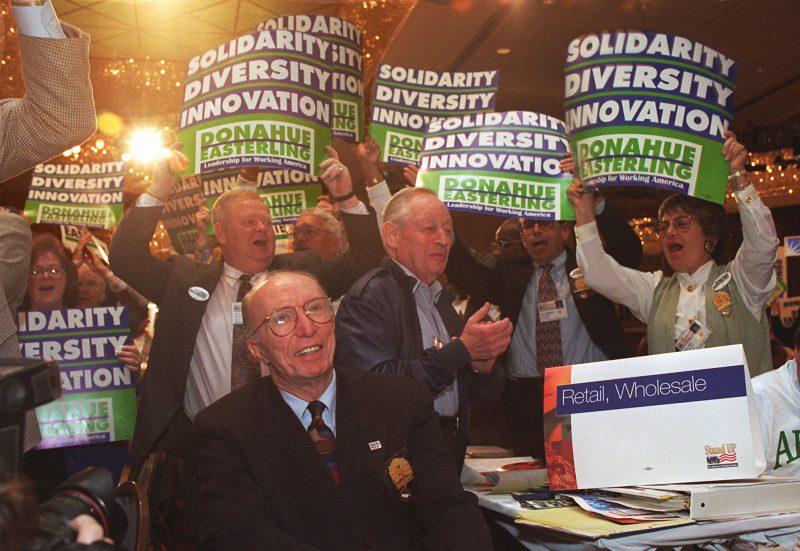Thomas Donahue, a labor organizer groomed by powerful AFL-CIO chief George Meany as a top political strategist and who for decades pressed union priorities in White House meetings, congressional races and trade policies, including a failed push to block a free-trade pact with Mexico and Canada, died Feb. 18 at a hospital in Washington. He was 94.
His wife, Rachelle Horowitz, said Mr. Donahue had several health issues and was hospitalized after a fall last week.
Until losing a leadership fight in 1995, Mr. Donahue was among the most feared and courted labor power brokers in Washington in an era before union clout in politics began to wane. He was only briefly the top figure at the AFL-CIO, but he was often the main envoy representing its dozens of unions and more than 12 million members from the late 1970s to the mid-1990s.
That made him a linchpin in deciding how the group would exert its influence, including political endorsements and alliances that leaned heavily Democratic — Sens. Edward M. Kennedy (Mass.), Daniel Patrick Moynihan (N.Y.) and others — but at times crossed the aisle with backing for pro-labor Republicans such as New York’s Jacob Javits, who served in the Senate and House.
Mr. Donahue was a natural in the favor trading and bridge building of retail politics. He had insider credentials from heading labor-management relations as an assistant labor secretary from 1967 to 1969 under President Lyndon B. Johnson, who was urged by Meany to pick Mr. Donahue for the job.
Mr. Donahue also could show off the street-smart gruffness of his Bronx roots, impress religious leaders with his grounding in Catholic social teachings or, when needed, turn on his internationalist poise from his years in Paris in the late 1950s overseeing labor-related projects for Radio Free Europe and the Free Europe Committee.
“My hopes for the labor movement are growth, dynamism, militancy,” he said in 1979 after the retirement of his mentor, Meany.
Beyond the world of politics, Mr. Donahue distinguished himself as a theorist on the future of U.S. organized labor and global competition. He was part of a deep soul-searching within the labor movement during the Reagan era of the 1980s, as the percentage of union workers in the U.S. private-sector workforce began to drop sharply.
His reports included a call to action in 1985, “The Changing Situation of Workers and Their Unions,” that portrayed America’s labor force as “behind the pace of change” and urged unions to find new ways to boost membership.
He also emerged as a prominent voice of alarm over Reagan’s push for deregulation and the early stirrings of a globalized economy, saying workers’ concerns were being ignored at the expense of lower prices and more consumer choices.
In many ways, those battles foreshadowed what Mr. Donahue described as his most stinging rebuke: the failure of the AFL-CIO and other labor groups to stop the North American Free Trade Agreement, or NAFTA, which took effect in 1994 to create a three-nation trade and economic bloc.
President Bill Clinton accused unions of using “roughshod and muscle-bound” tactics to try to turn Congress against NAFTA. Mr. Donahue, then the AFL-CIO’s secretary-treasurer, denounced Clinton as a traitor to the pro-labor traditions of the Democratic Party.
“I cannot exaggerate the depth of feeling on the issue,” Mr. Donahue said on NBC’s “Meet the Press.” “It burned very deeply.”
U.S. negotiators under President Donald Trump hammered out a new agreement with Canada and Mexico that took effect in 2020 to replace NAFTA and that made some changes to reflect the digital economy and push labor reforms in Mexico.
“Donahue was a steward of the labor movement during a major transitional period,” said Lane Windham, associate director of Georgetown University’s Kalmanovitz Initiative for Labor and the Working Poor.
“He had one foot in the era of a net-positive for labor as a force in politics and shaping the social contract,” she said, “and the other foot in the era of a net-negative for labor as neoliberal policies on trade were taking hold.”
Thomas Reilly Donahue Jr. was born in the Bronx on Sept. 4, 1928. As a boy during the Depression, Mr. Donahue said he first took notice of unions after he saw his father’s wages jump when he became a union-member deck hand on the Staten Island Ferry after working as a janitor.
Mr. Donahue served as a Navy seaman just after World War II, then graduated from Manhattan College in 1949 with a degree in labor relations.
While taking night-school classes at Fordham University’s law school — eventually getting his degree in 1956 — he had jobs including doorman at Radio City Music Hall.
In 1957, Mr. Donahue was named European labor program coordinator for U.S.-funded Radio Free Europe and the Free Europe Committee, an outreach position that brought him in contact with labor activists who had fled the Eastern Bloc. He described his three years in Cold War Europe as a sweeping education in the potential of worker movements to fight for political change.
Later in his career, Mr. Donahue led union calls to boycott apartheid-era South Africa, directed the AFL-CIO’s support movement for Poland’s Solidarity movement in the 1980s and backed efforts to strengthen workers’ rights groups in Cuba. He was chairman of a special advisory panel on labor and diplomacy with secretaries of state Madeleine Albright and Colin Powell.
“Either you stand on the side of democratic forces or you don’t,” he said.
In 1960, Mr. Donahue joined the national office of the Building Service Employees International Union in Washington. After his years in the Johnson administration, Mr. Donahue returned to the union role until 1973, when he was named executive assistant to Meany, a onetime Bronx plumber who became one of the country’s most commanding figures in organized labor.
After Meany’s retirement, Mr. Donahue was elected secretary-treasurer of the AFL-CIO. In 1995, Mr. Donahue stepped in as president to fill the last months of the term of the outgoing leader, Lane Kirkland.
Mr. Donahue then faced a leadership contest with John J. Sweeney, another longtime union chief who grew up just blocks from Mr. Donahue in the Bronx. The calls for change were too much for Mr. Donahue to overcome. Mr. Donahue was too close to Kirkland, who was seen as failing to stop the hemorrhaging of union membership and decline in political influence.
Mr. Donahue’s marriage to Natalie Kiernan ended in divorce. A son from their marriage, Thomas R. Donahue III, died in 2018.
In 1979, he married Rachelle Horowitz. In addition to his wife, of Washington, survivors include a daughter from his first marriage, Nancy Donahue of Annandale, Va.; and six grandchildren.
As union power in politics dwindled, Mr. Donahue became increasingly disenchanted over what he saw as U.S. foreign policy too heavily weighted toward expanding trade while paying less attention to the workers in the factories and fields in developing countries.
“I think it’s a delusion to believe that just because there are no longer dictators in X number of states or that the communist system has died, that democracy will flourish,” he said. “It won’t. It needs to be assisted and supported in every possible way. The critical element of democracy, we all believe, is a free trade union movement, the critical measure of democracy.”



























